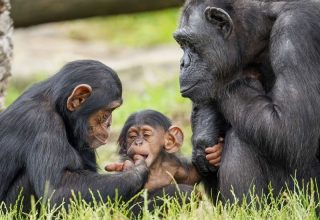
Northern Greenland is a polar desert today, but it was once a lush landscape filled with mastodons, reindeer, caribou and hares.
That’s the picture of an ancient ecosystem that has emerged from 2 million-year-old DNA extracted from desiccated dunes on the Peary Land peninsula on Greenland’s northernmost tip.
The discovery smashes the record for the oldest DNA ever sequenced and pushes the boundaries of what scientists, such as Eske Willerslev, thought possible.
“In 2005 I stated DNA could not survive more than 1 million years. I was clearly wrong,” said Professor Willerslev, of the University of Cambridge.
Last year, scientists sequenced DNA older than a million years that had been extracted from a Siberian mammoth.
But few large fossils have been found in Greenland. Instead, the latest discovery reported today in the journal Nature is taken from traces of DNA left in the landscape.
“You not only see DNA from a single organism, it’s in fact DNA from an entire ecosystem.”
The discovery not only changes what we know about some ancient species; Professor Willerslev believes it could provide a window into the fate of modern species.
“Investigating this time period is very important because it resembles the climate that we are heading towards with global warming,” he said.
“It really tells us that when the climate is changing, the ecosystem responds in very unpredictable ways.”
A snapshot of the past
Environmental DNA (eDNA) from the 2.4-million-year-old Kap København formation on the Peary Land peninsula provides a snapshot of a unique mix of plants, animals and marine life that lived at a time when Greenland was between 10–17 degrees warmer than it is at present.
“The ecosystem we recovered [has] no present-day analogue,” Professor Willerslev said.
Today, the area receives next to no rainfall and supports very little life apart from mosses, lichens and the occasional Arctic hare or musk ox scrabbling on the bare slopes.
But if you could travel back 2 million years, the grey-coloured landscape would have been a forest surrounding a large river carrying sediment into an ocean bay.
Traces of DNA reveal the bay’s warm waters contained coral, horseshoe crabs, algae and a multitude of microorganisms.
On land, there were conifers, deciduous and flowering trees, shrubs and herbs, many of which had not been detected before in the fossil or pollen record and are not found at all in Greenland today.
“No-one would have ever predicted mastodon was present in Greenland,” Professor Willerslev said.
The large, now-extinct elephant was only known to live in North America, which was separated from Greenland by the ocean even then.
The presence of reindeer so early in the DNA record was also surprising.
“People believe that reindeers originated way later in history, but apparently they are much older as a species compared to what we thought.”
There would have been carnivores too, but they did not show up in the eDNA sequences.
“The first things you are getting is what is most abundant,” Professor Willerslev said.
In other words, they just did not produce as much biomass as plants and herbivores, so were harder to detect.
Digging back into deep time
Professor Willerslev and his colleagues’ quest to find ancient DNA at the site began in 2006.
“We tried and failed, and failed, and failed until a couple of years ago,” Professor Willerslev said.
The first breakthrough came when the team discovered that minerals in the clay appeared to preserve DNA.
Ancient DNA is extremely fragile and easily broken down by temperature and microbes: the warmer it is, the faster it breaks down.
But the DNA at Kap København was preserved even though temperatures were higher 2 million years ago and the sediments were not frozen for at least 20,000 years, said team member Morten Allentoft of Curtin University.
“Temperature still has an effect on DNA preservation, but it does seem like the way DNA is bound to these clay particles protects them against microbe attack,” Professor Allentoft said.
The team then used advanced technology to target 41 clay samples from five sites and sequence very short fragments of DNA.
They compared the eDNA with genomes of living and extinct species to work out where the Greenland species sat in their family trees based on the predicted rate of evolution.
This revealed they were ancestors of the plants, mastodons, reindeer and hares that came after them.
“You can still place them on the evolutionary lineage leading to the present species, but it’s quite obvious that something has happened over the last 2 million years,” Professor Allentoft said.
Professor Willerslev said the DNA of some of these species may provide clues about how they adapted to warmer conditions.
“In principle, it contains a road map to understand how one could even genetically modify taxa to be more resilient.”
Where to next?
The team hope the discovery will eventually lead to the sequencing of even older DNA.
The next step is to investigate similar sites in Canada, where some of the plants and animals in ancient Greenland may have come from.
They are also investigating how to improve the extraction of DNA from clay so the technique could be used for other locations around the world such as the drier regions of Australia.
“I think that is definitely doable, even now without any refining of the technique,” Professor Willerslev said.
The oldest ancient DNA we have in Australia is around 30,000 years, said Jeremy Austin, an evolutionary biologist at the Australian Centre for Ancient DNA.
“If we had sediment records with DNA in them that went back 50,000 years, we could be picking up all or most of the Australian megafauna species,” Dr Austin said.
“We could actually get genetic signatures of what populations of megafauna were doing right up to their extinction.”
But Dr Austin is yet to be convinced the record-breaking feat by the Greenland team would be achievable outside a handful of polar or high-elevation sites.
“It’s still very cold, the average summer temperature [in Greenland] is around 10 degrees.”
It could all come down to whether or not the effect seen in Greenland’s clay could translate elsewhere.
“If clay mineral protection of DNA is somehow buffering the temperature component, then perhaps we can go looking for ancient DNA records in parts of the world where people have traditionally thought there’s no point looking.”



































 The World Observer Media produces a daily online newspaper, a daily Arabic online newspaper and a monthly printed Arabic/English magazine and a weekly printed Arabic/English newspaper.
The World Observer Media’s mission is to entertain and educate all generation from the Ethnic Communities in Australia, who are interested in local, national and foreign information.
The World Observer Media produces a daily online newspaper, a daily Arabic online newspaper and a monthly printed Arabic/English magazine and a weekly printed Arabic/English newspaper.
The World Observer Media’s mission is to entertain and educate all generation from the Ethnic Communities in Australia, who are interested in local, national and foreign information. 
